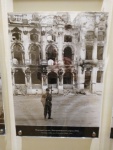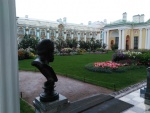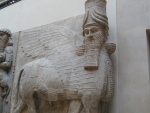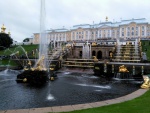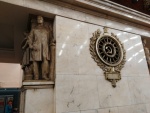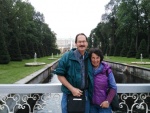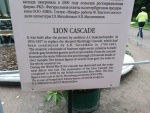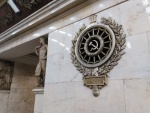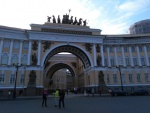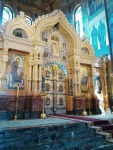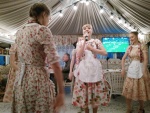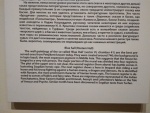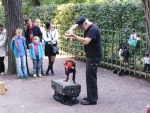 We’ve both wanted to go to St. Petersburg for many years, even before Glasnost. We had seen an exhibition of the Hermitage Museum’s masterpieces in the US, and had been reading about Peterhof and Catherine’s Palace.
We’ve both wanted to go to St. Petersburg for many years, even before Glasnost. We had seen an exhibition of the Hermitage Museum’s masterpieces in the US, and had been reading about Peterhof and Catherine’s Palace.
Our first challenge was getting a visa. For some reason, Russia doesn’t make it easy for tourists to visit. While we understand that some governments use the visa system as a political football, the only ones who seem to be affected by bizarre visa policies are tourists. In the case of traveling to Russia, we found that we could not apply by mail, but either had to go to NY or Washington to apply in person, or have a passport agency. We chose passportvisasexpress.com, who were very efficient and helpful. We also opted to get the required “letter of invitation” from our hotel (see below). Equipped with time, and all the required documents, we proceeded to complete the 8-page questionnaire, which included a list of EVERY country we’d ever visited! Passport Visas Express corrected our errors, and we got our visas.
But St. Petersburg was worth it. While our focus was on the Hermitage, we found so much else to enjoy there. Every guidebook says that it takes more than a day to see the Hermitage. Their collection is enormous, the museum takes up multiple buildings, and the layout is confusing. Luckily it wasn’t as crowded as we had expected. We didn’t need to purchase tickets in advance, as the queue was short. We spent most of one full day exploring their vast collection, getting lost, going in circles, and then seeing still more. We managed to see pretty much everything in one day, and then that night reviewed what we had seen and missed. We went back the second day and completed the collection (more or less), and had time to explore some of the city.
St. Petersburg looked to Europe for design. It has the canals of Amsterdam and the architecture of Paris. Most of the buildings were constructed during the belle epoch by Tsar Nicholas II. The city’s buildings are stunning, over the top, and fully restored. The Russians are justifiably proud of the city’s art, and preserved the historic center. The compactness of the scale makes it easy to explore by foot. The traffic is annoying; Nevsky Prospekt, the main street thru the historic/tourist part of the city is choked with traffic at all hours. Nevertheless, most of the sights we wanted to see were within a 15 minute walk of our hotel. This included the amazing Church of the Spilled Blood, an onion-domed mosaic extravaganza, perfectly situated on a lovely canal.
Peterhof
A short boat trip out of the city brought us to Peterhof, a rococo palace that makes Versailles seem like a quaint country cottage. Peter the Great wanted to outdo the Europeans, and he succeeded. What’s more amazing was that in WW2, in order to deprive the Nazis of a victory in capturing the palace, the Russians bombed it to bits. Luckily, the staff took all the art objects first. After the war, they painstakingly reconstructed the entire palace complex, reinstalled the art, and opened it to the public. The Russians use of gold is without equal. The gardens are exhaustingly sprawling. We could have spent days here and not have seen it all. We took the boat to the palace, and the bus/metro home, stopping to see the Soviet art-deco subway stations.
Catherine’s Palace (Tsarskoye Selo)
Constructed by Catherine I, this enormous rococo “summer” palace cannot be missed. There’s a difficult-to-understand choice of itineraries inside the palace, we simply did one, slipped around a staircase, and then went in again with the second itinerary. The palace interior is without equal, decorated with exquisite decorative furniture, Russian and Western European paintings, collections of porcelain, as well as amber and bronze sculptures. The gem of the Palace is the Amber Room, a vast chamber that contained more than 6 tons of amber. Although looted by the Nazis in WW2, it has been stunningly recreated, with amber panels, swirling gold leaf and reflective mirrors. The extensive lavish formal gardens are from the 18th and 19th centuries, with statues and monuments throughout.
Other things to see:
The art-deco Stalin-era train stations, decorated with Soviet Star.
Admiralty buildings
Kazan Cathedral
Church on the Spilled Blood
Ballet (we saw Swan Lake).
Pishke – a soviet-era donut shop. The donuts are ok, the scene is what’s cool.
Russian Museum – Although Russian artists are largely unknown in the west, their work is among the most impressive we’ve seen.
Various walks through the Nevsky Prospekt area.
Peter and Paul Fortress – we never made it there, but most people visit the fortress. Maybe we’ve seen enough military forts in our lifetime.
Just walking around. We used Frommer’s self-guided walking tours, but all the books seemed to cover the same highlights.
Reviews
Airbnb
Gerard-Paris
Perfect location, super-comfortable apartment, just a few steps from the Metro. Gerard was responsive and welcoming. We’ve been to Paris many times, and this is our favorite neighborhood—and having an elevator is fantastic.
Golden Triangle Hotel in St Petersburg
This is the absolutely perfect hotel. From the décor, incredible breakfast, warm welcome, helpful staff, quiet alley setting, and perfect location, this hotel has everything.
Restaurants
Prospekt
Charming small traditional Russian restaurant, very close to the Admiralty. The food was perfect, and the waitress couldn’t have been nicer.
Gogol Restaurant
Although we arrived without reservations, they seated us without a problem. The restaurant’s interior was furnished like someone’s home, the food was the best we had in Russia, and the waitress clearly beamed with pride when we complimented the dinner. The prices were very reasonable.
Stolle
Simple, fast, and low-cost – we had two incredibly delicious savory pies! With such great “fast” food, we couldn’t figure out why Russians went to McDonalds and Burger King.
Teremok
People in St. Petersburg are passionate about blinis, crepe-like sweet and savory quick treats that are ubiquitous there. Teremok, although it’s not exactly set up for tourists (no obvious English menu), is worth it – fantastic cheese blinis here. Find someone to help translate; these could become a habit! We later found a branch in Manhattan.
Chacha
Georgian-style food, another incredibly good (and inexpensive) dinner right near the Church on the Spilled Blood.
Paris
Au Bon Couscous
One of the restaurants on “Rue de la Huchette,” the cluster of eateries in the 5th Arrondissement. We chose this based on the menu and the offer of free glasses of wine, and we were glad we did. Both the tagine and couscous dishes we ordered were flavorful, well made, and inexpensive. The service was warm and friendly. The dishes were Algerian style, subtly different from Moroccan and Egyptian, and we were told more “berber” in seasoning.
Le Restaurant Des Poètes
This quiet restaurant was neither bad nor great. The atmosphere was also not what one would expect in a Passage, feeling more like an alley. To add to the evening (and I can’t blame the restaurant) the two women next to us were speaking so loudly that we had trouble hearing each other. With just a few inches separating tables, this is prone to happen. Sigh.
Hall 1900 Bistrot Corse
We stopped here for drinks and a light dinner – a cheese plate. The waiter’s English was wonderful, and he joked with us making the evening memorable. The cheese plate was HUGE, and the cheeses were all excellent.
RER
Normally, we wouldn’t review a commuter rail system. Their job is simply to get you from one place to another. But RER is so totally and maddeningly incompetent; they deserve every criticism they receive. I could rail on (sorry!) about every one of their missteps, but will focus on one: arrival at CDG airport. This is where locals and visitors – many who may not speak French- need to buy train tickets to Paris and beyond. The queue at the office was insanely long, and the queues at the machines were 30-45 minutes long. Not only didn’t they have anywhere near enough working machines here, the software was clearly written by people who despised rail passengers, and wanted to make it as difficult for them as possible, and who used Google translate for the English screens. It should not take an hour to buy rail tickets.

